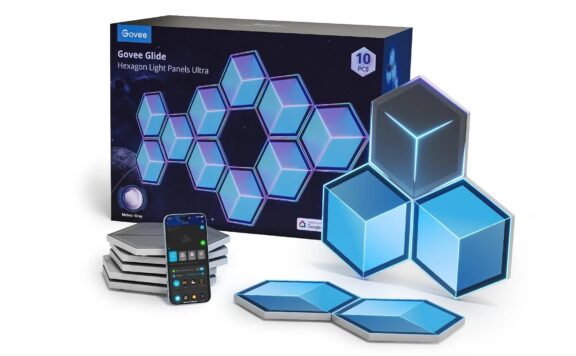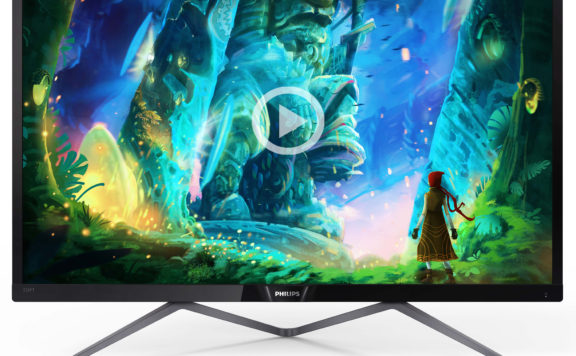Govee recently updated their Envisual TV Backlight T2 kit, adding a third length option to its lineup that will fit up to 100” TVs. The dual-camera setup also received some software upgrades to make it even more accurate, customizable, and user friendly than the original out-of-box experience. I’ve been on a bit of an RGB review binge as of late, and even though I was already in the middle of reviewing Nanoleaf’s 4D screen mirror kit, when Govee asked if I was interested in trying out the Envisual TV Backlight T2 kit, I quickly responded with a, “heck yeah!” Spoiler alert, Govee’s T2 is the kit that is still on the back of my TV.
Specifications
- Price (Govee.com): 55-65” TV: $119.99, 75-85” TV: $129.99, 98-100” TV: $159.99
- Length: 3.8m/5.0m/6.4m
- LED Density: 60 LED/m
- Camera Setup: Dual-Camera
In The Box
Opening up the box, there are three items that make up the Govee T2 backlight kit: the camera, a controller, and a lightstrip. Also included in the box are the quick start guide and user manual, power adapter, a couple of bags of reinforcement clips for the lightstrip, and an 8-pack of orange foam squares.
The lightstrips now come in three sizes. The newest strip is big enough for the largest TVs out there today and is made for 98”-100” TVs. The mid-sized strip fits 75”-85” TVs, and the smallest strip works with 55”-65” screens. Each lightstrip is actually comprised of four individual pieces with wires connecting them at their ends. The strips are configured in a 16:9 ratio to fit a standard widescreen TV, and Govee has packed in 60 LED per meter to provide more accurate color matching.
While the lightstrips are the star of the show, the T2 camera is the workhorse of the kit. I say camera, but the T2 actually uses a dual-camera setup to capture screen content faster and more accurately than a single camera. The cameras are housed in an oblong head attached to a short arm that sits on top of your TV. The whole apparatus is held in place by a small counterweight that rests against the back of the TV.
Each camera is responsible for continually capturing the image on one half of the screen. These images are passed on to the T2’s control unit. Using Govee’s Envisual technology, the screen capture is divided into individual zones, with each zone’s color data then passed on to the lightstrip to create the screen-mirroring effect.
Although matching the screen in video mode is its primary function, screen mirroring is but one of the T2’s lighting functions. Like Govee’s other products, the T2 can pull regular lighting duty by setting it to a single hue or multiple colors along its length. In music mode, the light strip will shine and dim to the rhythm of any sound source within the room. In Scene mode, you can choose one of the myriad lighting effects found in the Govee app to liven up any event or party, and just in case you don’t find any presets that suit your mood, you can create your own light show in DIY mode. There’s even a DreamView mode that will sync up any of your other Govee lighting kits up to the T2 to expand your screen mirroring effect across the entire room.
Installing The Govee T2
The installation of the Govee T2 is extremely simple. First, make sure to clean the back of the TV so that any accumulated dust doesn’t prevent the adhesive on the backside of the lightstrip from sticking. Then, one by one, you stick each section of the lightstrip to the edge of your TV. Once all four sections are in place, you can use the retaining clips to ensure the ends of the lightstrips don’t peel up over time.
For my 75” TV, the strips span nearly the entire length of each edge; for larger TVs, you will need to center each strip for the best results. The lightstrip isn’t trimmable, so picking the right size for your TV is important and leaves anyone with less than a 55” TV out in the cold.
With the lightstrip in place, you then place the camera mount at the top-center of the TV, ensuring that it is perpendicular to the screen. A piece of double-sided tape is included if you have trouble keeping the camera in place, but I didn’t have any issues.
Finally, you plug the wires from the camera, lightstrip, and power adapter into the Govee controller and stick it to the back of the TV. The controller can be used to power on and control the basic functionality of the system, so you may want to mount it close to the edge of the TV, but odds are you’ll be controlling everything through the Govee app, so actual placement really won’t matter much.
Configuring And Using The Govee T2
To ensure the best visuals possible, the Govee app is used to configure the T2 camera and lightstrip to your specific TV and viewing space. Once the app is installed on your Apple or Android smartphone and connected to a 2.4gHz WiFi router (802.11 b/g/n), The app will run you through the calibration setup to identify the edges of your screen. To do so, you attach the foam blocks to the corners and mid-points of the screen. The blocks have a very light adhesive on them to stick them to the screen; I am fearful of attaching anything directly to my screen, so I attached them to the bezel (there is also a video available on YouTube that places an image on the screen to simulate the foam blocks, but I found it didn’t work as well as using the real thing). You then use the app to identify the calibration points, effectively teaching the camera the boundaries of your screen.
With the camera setup completed, all that is left is to configure the lighting effects to your personal preferences. The Govee app walks you through all of the necessary steps, from confirming the location of each lightstrip to tuning the saturation, brightness, and white color temperature of the strips.
Configuring the lighting to your tastes is arguably the most time-consuming part of the entire setup, but it is vital to your viewing enjoyment. Using the default settings, I found the saturation and brightness to be overwhelming, almost something only a true lover of the “more is better” RGB lighting crowd could enjoy. But over the course of daily use, I have been tweaking the settings and have pretty much found a good balance where the lighting effects are vivid enough to add to the scene on my TV without overpowering the actual content.
Final Thoughts
Before I began my TV backlight journey, I was concerned that the screen mirror effects of a backlight kit, like the Govee T2, would be a distraction – we all know that the best way to watch movies is in a dark room, right? And right out of the box, I would say that my concerns were justified. The colors pouring over my walls were extremely vibrant, and they didn’t really match up to what I was seeing on the screen. It was sensory overload.
But the T2’s ability to produce that extreme lighting is just part of what it can do. The strength of the kit lies in the functionality and customizability of the lighting effects through the Govee app. With the app, you can adjust the backlight effect to your individual tastes. It took a little bit of toying around with the settings, but when I finally dialed everything in, the T2 helps to fully immerse you in whatever you are viewing. Any lightstrip and camera can display colors, but the Govee T2 tailored the experience to my individual tastes, something that makes the premium price worth every penny.








